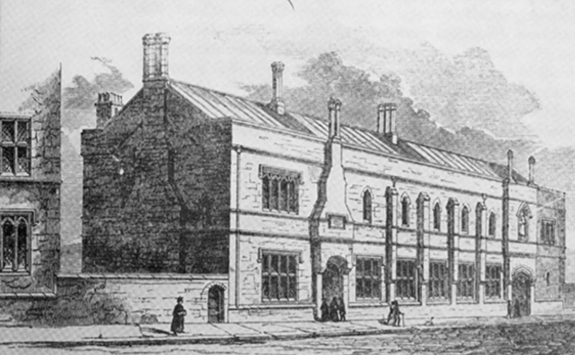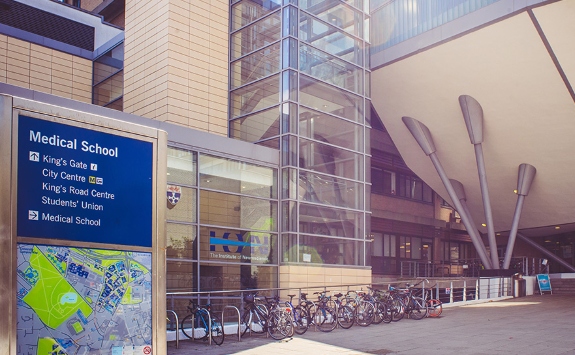University graduation medallion dating back from 1888 discovered in Australian vegetable patch
A medallion awarded to a Newcastle Medical School alumnus upon their graduation in the late 19th century has been unearthed in the unlikeliest of places – a back garden in East Perth, Australia!
28 February 2024
History of Newcastle Medical School unearthed
Michael Melrose, whose family emigrated from Yorkshire in 1965 to West Australia, was preparing his vegetable patch when he stumbled upon the award (pictured) which was inscribed with ‘College of Medicine, Newcastle upon Tyne’ and the name H. McLagan. Wanting to find out more about this mysterious object, Michael reached out to Newcastle University via email. He said:
“I found the medallion in the late 60s while digging the garden for a veggie patch and thought it was a good find. It has been packed in my gear until recently, when I came across it and decided to clean it up and find out what I could about it.
“I was surprised and elated by the news the university was able to uncover. I've had it in my collection for 50 odd years now and being retired decided it was time to do something about it!”
.png)
Research conducted by the university’s archivists deduced that the medallion was an award presented to student H. McLagan upon his graduation from Newcastle College of Medicine, which at that time was based on Orchard Street near Newcastle Central Station and was a college of the University of Durham. It is unclear whether this prize was awarded to all students attending the summer session, or if this was a special accolade awarded to H. McLagan upon the end of his studies.
Discover the history of Newcastle University revealed by this find below!
The evolution of Newcastle University
Newcastle University began life as two 19th century educational establishments: the College of Medicine (founded in 1834) and the College of Science (founded in 1871). These colleges merged to become Armstrong College and later King’s College of the University of Durham, before Newcastle University became an independent institution in 1963.
After starting life through lectures given at the Barber Surgeons’ Company Hall in the Manors, the College of Medicine found a permanent home in Orchard Street near Newcastle Central Station in 1852, coinciding with formal recognition of the qualifications it awarded and the creation of the Medical Register in 1858.

With the expansion of the railways, both colleges were served notice to vacate their premises in the 1880s. The College of Medicine relocated to Northumberland Road in 1889, where it enjoyed one of the most up to date premises in the country. This is now Northumbria University’s Sutherland Building.
Construction of a new building for the College of Science began in 1887 and is now known as the Armstrong Building, the heart of Newcastle University campus and where thousands of students graduate each year.
To this day, the Great Hall on the Sutherland Building’s first floor still features the ceiling mouldings of shields of the college’s original benefactors: Henry Armstrong, Thomas Cargill Nesham, George Edward Williamson, Charles John Gibb, Sir David Drummond, Sir Thomas Oliver, Samuel McBean, William Arnison, James Murphy, Charles Gibson, Frederick Page, and Sir George Hare Philipson.
.png)
.png)
A father of medicine and midwifery at Newcastle University
One of the benefactors recognised in the Sutherland Building is also named on the medallion unearthed in Michael’s vegetable patch.
Thomas Cargill Nesham was a Lecturer in Anatomy and Midwifery at the College of Medicine from 1864 until his death in 1899, and so very likely taught the student H. McLagan.
Thomas, who was born in 1841, was one of 12 children born to William Nesham – also a doctor – and Margaret Nesham (nee Cargill). He was a Member of the Royal College of Surgeons of England and a Licentiate of the Society of Apothecaries (1863). After qualifying as a doctor, Thomas became a Medical Tutor, and later Lecturer on Anatomy, at the Newcastle College of Medicine. He remained at the college when it became the University of Durham College of Medicine, lecturing on anatomy and midwifery.
Alongside his academic career, he was Physician Accoucheur (Midwife) at the Newcastle Lying-In Hospital (as was his father) and Physician at the Hospital for Women in Newcastle. Thomas also played cricket for Alnwick, often under the alias A Paradox.
‘Lying-in’
Lying-in was the phrase used for the period of labour and the recovery afterwards. Lying-in hospitals emerged in the 1750s and were charities aimed at poor (but crucially, married) women who lacked the means to access good healthcare. For unmarried pregnant women, their only option was often the workhouse.
Newcastle’s Lying-in Hospital (pictured below) was established in 1760 and was the first of its kind outside of London. In the late 19th century, the hospital was located on New Bridge Street in a building designed by renowned Newcastle architect, John Dobson. The building still stands today, not far from the Laing Art Gallery.
.png)
Throughout the 19th century, the birth experience witnessed many experimental practices in these hospitals. Although most women continued to give birth at home – indeed it was not until the 1940s that more than 50% women gave birth in hospital – midwifery care had shifted, and the practices and ideas tested in the hospitals affected home delivery.
For example, light and fresh air were seen as important; instruments such as midwifery forceps became more common; and men began to be called into the birth chamber in favour of the traditional female midwives, particularly by the middle- and upper-classes.
Supporting midwifery education in Newcastle
Another name inscribed on the discovered medallion is Charles Gibson, who was a Lecturer in Midwifery and Disease of Women and Children at Newcastle College of Medicine.
Charles was born in 1820 in the small village of Bell’s Close, on the banks of the Tyne near Scotswood and Lemington. In 1835, he was apprenticed as a medical practitioner in Newcastle and three years later he became attached as a student to the Newcastle Infirmary, and to the Newcastle School of Medicine and Surgery. By 1842 he was a Member of the Royal College of Surgeons of England.
Charles went on to gain an MD from St. Andrew’s University in 1851 and during his studies, he lectured in Anatomical Demonstrations and Dissections at the Newcastle School of Medicine. On the formation of the new College of Medicine, he became a Lecturer on Midwifery and Diseases of Children and remained there until his death in 1894, upon which he bestowed a scholarship in midwifery to his employer.
Newcastle Medical School today
Newcastle University is home to one of the largest integrated medical teaching and hospital complexes in the country. We provide excellent undergraduate and postgraduate training and our regional medical school spans the North East of England and Cumbria. This includes Clinical Learning centres across all NHS trusts.
As the largest school in the Faculty of Medical Sciences, we are responsible for the delivery of the Undergraduate Medical (MBBS), Postgraduate Medical Education (Certificate, Diploma and Masters) and Physician Associate programmes.
Our work contributes significantly to the reputation of Newcastle University for Teaching Excellence.
A very large number of people contribute to our programmes. Within the School we employ more than 100 members of staff. Many more associated with the programmes work in NHS settings across the region to deliver a first-class clinical experience for our students.

